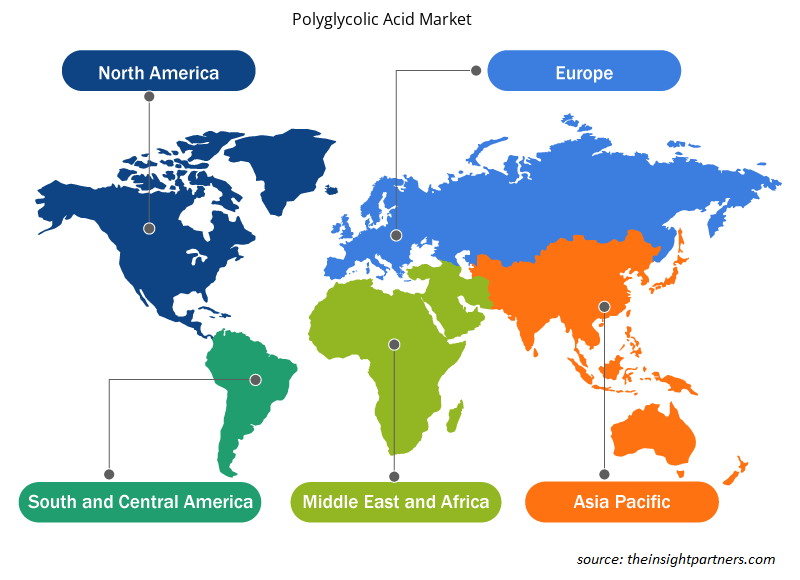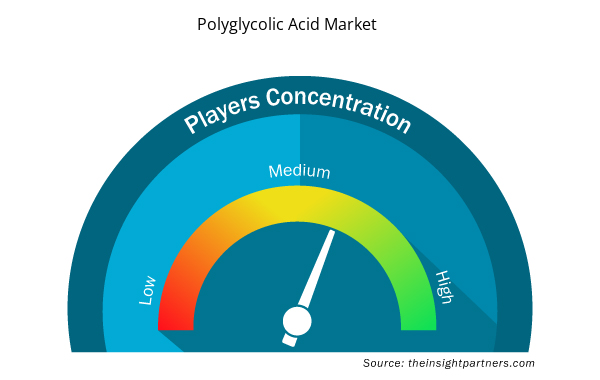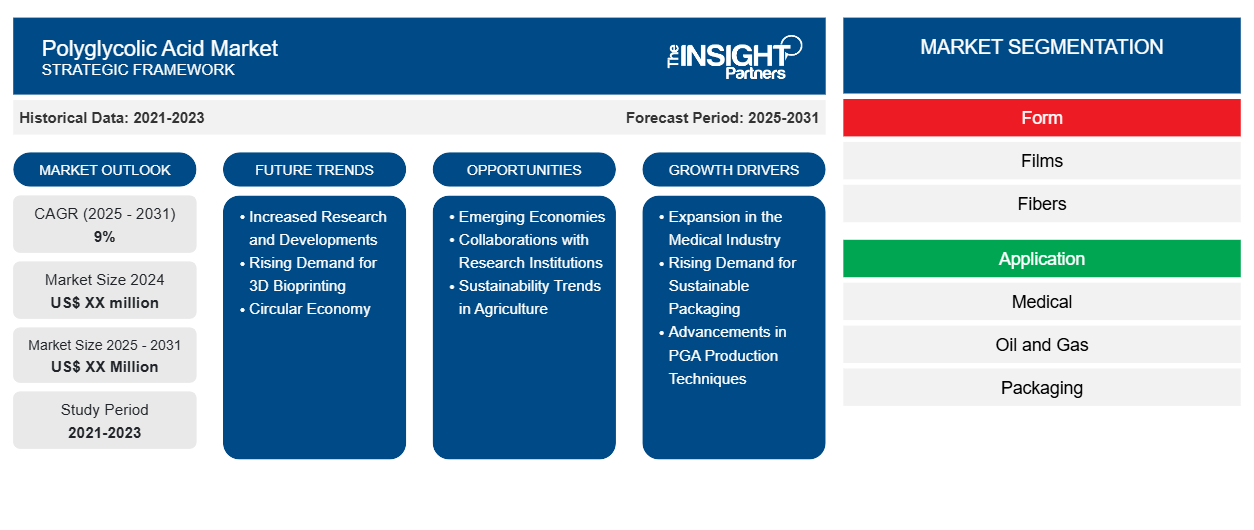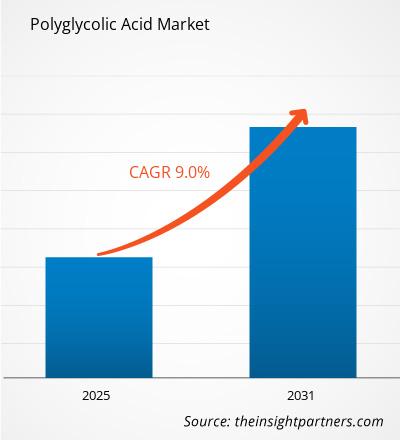Se espera que el mercado de ácido poliglicólico registre una CAGR del 9% entre 2023 y 2031, con un tamaño de mercado que se expandirá de US$ XX millones en 2023 a US$ XX millones en 2031.
El informe de mercado de ácido poliglicólico está segmentado por forma (películas, fibras y otros). El mercado está segmentado en función de la aplicación (médica, petróleo y gas, embalaje y otros). El análisis global se desglosa aún más a nivel regional y de los principales países. El tamaño del mercado y el pronóstico a nivel global, regional y de país para todos los segmentos clave del mercado están cubiertos bajo el alcance. El informe ofrece el valor en USD para el análisis, los segmentos, las regiones y los países anteriores. El informe cubre las tendencias del mercado, así como la dinámica del mercado, como los impulsores, las restricciones y las oportunidades clave. El informe también cubre el panorama de la industria y el análisis de la competencia que cubre la concentración del mercado, el análisis del mapa de calor, los actores destacados y los desarrollos recientes en el mercado.
Propósito del Informe
El informe Polyglycolic Acid Market de The Insight Partners tiene como objetivo describir el panorama actual y el crecimiento futuro, los principales factores impulsores, los desafíos y las oportunidades. Esto proporcionará información a diversas partes interesadas del negocio, como:
- Proveedores/fabricantes de tecnología: Para comprender la dinámica cambiante del mercado y conocer las oportunidades potenciales de crecimiento, lo que les permitirá tomar decisiones estratégicas informadas.
- Inversionistas: Realizar un análisis exhaustivo de tendencias sobre la tasa de crecimiento del mercado, las proyecciones financieras del mercado y las oportunidades que existen en toda la cadena de valor.
- Órganos reguladores: Regular las políticas y vigilar las actividades del mercado con el objetivo de minimizar los abusos, preservar la confianza de los inversores y defender la integridad y la estabilidad del mercado.
Segmentación del mercado del ácido poliglicólico
Forma
- Películas
- Fibras
Solicitud
- Médico
- Petróleo y gas
- Embalaje
Personalice este informe según sus necesidades
Obtendrá personalización en cualquier informe, sin cargo, incluidas partes de este informe o análisis a nivel de país, paquete de datos de Excel, así como también grandes ofertas y descuentos para empresas emergentes y universidades.
- Obtenga las principales tendencias clave del mercado de este informe.Esta muestra GRATUITA incluirá análisis de datos, desde tendencias del mercado hasta estimaciones y pronósticos.
Factores impulsores del crecimiento del mercado del ácido poliglicólico
- Expansión en la industria médica: una de las principales razones del aumento del mercado del ácido poliglicólico (PGA) es su amplio uso en el sector médico, especialmente en la fabricación de suturas quirúrgicas, sistemas de administración de fármacos e ingeniería de tejidos, entre otras aplicaciones. Los estudios han demostrado que el PGA es biocompatible y bioabsorbible, lo que significa que las prótesis de larga duración fabricadas con este material no están disponibles en el mercado. Con la mejora de la tecnología sanitaria y la seguridad de las cirugías ortopédicas, es probable que aumente el uso del biopolímero.polyglycolic acid (PGA) market is its extensive use in the medical sector, especially in the manufacturing of surgical sutures, drug delivery systems, and tissue engineering, among other applications. Studies have shown that PGA is biocompatible and bioabsorbable which means longevity prosthesis made out of this material is not available in the market. With improved health care technology and orthopaedic surgeries safety, there is likely to be an increase in use of the biopolymer.
- Demanda creciente de envases sostenibles: existe una creciente necesidad de ácido poliglicólico, especialmente en envases, debido a la creciente demanda de soluciones sostenibles y compostables. Las crecientes prohibiciones al uso de plástico para envases y la creciente preferencia de los consumidores por materiales respetuosos con el medio ambiente hacen que sea fácil utilizar PGA en este caso. Sus otros atributos incluyen la biodegradabilidad y el rendimiento que lo presentan muy favorablemente en el mercado de envases ecológicos.polyglycolic acid, especially in packaging, owing to the rising demand for sustainable and compostable solutions. The increasing bans on plastic use for packaging and the growing consumer preference for environmentally concerned materials make it easy to use PGA in this case. Its other attributes include biodegradability and performance which present it very favourably in the green packaging market.
- Avances en las técnicas de producción de PGA: Además, los métodos de producción de ácido poliglicólico también han mejorado con la aparición de formas nuevas y más rápidas de fabricar el compuesto y mejores técnicas de modificación, que han mejorado su producción y reducido el costo de producción. Esto crea una tendencia a desarrollar una tecnología eficiente para la síntesis de poliácido de alta calidad. Este enfoque está motivado por el mercado disponible para este tipo de polímero y también ayuda a avanzar en este segmento de mercado en particular.
Tendencias futuras del mercado del ácido poliglicólico
- Aumento de la investigación y el desarrollo: la creación de derivados multipropósito del ácido poliglicólico se está convirtiendo en una herramienta para que los diseñadores modifiquen el compuesto con un fin determinado. Los investigadores se centran en el diseño de composiciones y mezclas que contienen PGA con vistas a mejorar la durabilidad mecánica, la resistencia térmica y otras características funcionales. Esto probablemente ayudará a encontrar nuevas formas de utilizar los PGA en otros sectores fuera de la medicina, por ejemplo, en el envasado, la agricultura y la industria biomédica.
- Demanda creciente de bioimpresión 3D: se prevé que la creciente tendencia de la bioimpresión 3D cree una enorme oportunidad para el mercado de PGA. En medio de una creciente necesidad de productos específicos de ingeniería de tejidos, PGLA es útil en tecnologías de impresión 3D basadas en medicina regenerativa. Esto dará como resultado el uso avanzado de las TIC en la fabricación de andamios para el crecimiento y la reparación de tejidos, lo que mejorará el uso del material en biomedicina.
- Economía circular: la conciencia de la sostenibilidad en la economía mundial provoca cambios en el enfoque lineal tradicional hacia los principios de una economía circular. También se trata de crear productos avanzados e innovadores, pero sostenibles y totalmente de base biológica como el PGA. A medida que las industrias apuntan a reducir las emisiones de carbono y reducir los desechos, se incorporará el diseño productivo de los materiales compuestos de American-PGA, por lo que serán aceptados en la mayoría de los mercados.
Oportunidades de mercado del ácido poliglicólico
- Economías emergentes: Las regiones de Asia Pacífico y América Latina son prometedoras para el mercado del ácido poliglicólico, ya que en ellas hay economías emergentes. Con el desarrollo industrial y el aumento de las inversiones en atención sanitaria en estas regiones, aumentará el alcance de los materiales biodegradables y las aplicaciones médicas avanzadas. Esta tendencia es favorable para las empresas, ya que les permite construir plantas de producción en estos mercados o forjar alianzas.
- Colaboraciones con instituciones de investigación: es posible mejorar la innovación en áreas de aplicación y las tecnologías de producción de PGA mediante la colaboración con institutos de investigación y universidades. Esto facilitará la fabricación de productos innovadores que tienen aplicaciones únicas, como la medicina, el envasado y la agricultura con PGA. Esta estrategia puede ser útil para mejorar la competitividad en el mercado y fomentar la participación de agentes clave durante un largo período.
- Tendencias de sostenibilidad en la agricultura: En el sector agrícola, las perspectivas para la PGA son inmensas, especialmente en la aplicación de películas biodegradables para mantillo, recubrimientos de semillas y fertilizantes de liberación controlada. A medida que el mundo avanza hacia prácticas sostenibles en la agricultura, la reducción de los desechos de materiales plásticos en la agricultura requerirá el uso de productos biodegradables como la PGA. Por lo tanto, esta es una oportunidad para que las empresas diversifiquen sus productos y aprovechen el mercado emergente.
Perspectivas regionales del mercado del ácido poliglicólico
Los analistas de Insight Partners explicaron en detalle las tendencias y los factores regionales que influyen en el mercado del ácido poliglicólico durante el período de pronóstico. Esta sección también analiza los segmentos y la geografía del mercado del ácido poliglicólico en América del Norte, Europa, Asia Pacífico, Oriente Medio y África, y América del Sur y Central.

- Obtenga datos regionales específicos para el mercado de ácido poliglicólico
Alcance del informe de mercado de ácido poliglicólico
| Atributo del informe | Detalles |
|---|---|
| Tamaño del mercado en 2024 | XX millones de dólares estadounidenses |
| Tamaño del mercado en 2031 | US$ XX millones |
| CAGR global (2024 - 2031) | 9% |
| Datos históricos | 2021-2023 |
| Período de pronóstico | 2025-2031 |
| Segmentos cubiertos | Por formulario
|
| Regiones y países cubiertos | América del norte
|
| Líderes del mercado y perfiles de empresas clave |
|
Densidad de actores del mercado de ácido poliglicólico: comprensión de su impacto en la dinámica empresarial
El mercado del ácido poliglicólico está creciendo rápidamente, impulsado por la creciente demanda de los usuarios finales debido a factores como la evolución de las preferencias de los consumidores, los avances tecnológicos y una mayor conciencia de los beneficios del producto. A medida que aumenta la demanda, las empresas amplían sus ofertas, innovan para satisfacer las necesidades de los consumidores y aprovechan las tendencias emergentes, lo que impulsa aún más el crecimiento del mercado.
La densidad de actores del mercado se refiere a la distribución de las empresas o firmas que operan dentro de un mercado o industria en particular. Indica cuántos competidores (actores del mercado) están presentes en un espacio de mercado determinado en relación con su tamaño o valor total de mercado.
Las principales empresas que operan en el mercado del ácido poliglicólico son:
- B. Braun Melsungen AG
- BMG Incorporated
- Corbion NV
- Suturas DemeTech
- Industrias Evonik
Descargo de responsabilidad : Las empresas enumeradas anteriormente no están clasificadas en ningún orden particular.

- Obtenga una descripción general de los principales actores clave del mercado de ácido poliglicólico
Puntos de venta clave
- Cobertura integral: el informe cubre de manera integral el análisis de productos, servicios, tipos y usuarios finales del mercado de ácido poliglicólico, proporcionando un panorama holístico.
- Análisis de expertos: el informe se compila sobre la base de un profundo conocimiento de expertos y analistas de la industria.
- Información actualizada: El informe asegura relevancia comercial debido a su cobertura de información reciente y tendencias de datos.
- Opciones de personalización: este informe se puede personalizar para satisfacer los requisitos específicos del cliente y adaptarse adecuadamente a las estrategias comerciales.
Por lo tanto, el informe de investigación sobre el mercado del ácido poliglicólico puede ayudar a abrir camino para descifrar y comprender el escenario de la industria y las perspectivas de crecimiento. Si bien puede haber algunas preocupaciones válidas, los beneficios generales de este informe tienden a superar las desventajas.
- Análisis histórico (2 años), año base, pronóstico (7 años) con CAGR
- Análisis PEST y FODA
- Tamaño del mercado Valor/volumen: global, regional, nacional
- Industria y panorama competitivo
- Conjunto de datos de Excel



Report Coverage
Revenue forecast, Company Analysis, Industry landscape, Growth factors, and Trends

Segment Covered
This text is related
to segments covered.

Regional Scope
North America, Europe, Asia Pacific, Middle East & Africa, South & Central America

Country Scope
This text is related
to country scope.
Preguntas frecuentes
Development of multifunctional PGA derivatives is expected to be the key market trends.
Based on application, the medical segment is expected to witness the fastest growth during the forecast period.
Based on geography, Asia Pacific held the largest share of the polyglycolic acid market due to the strong growth of the packaging and medical industry.
Increasing demand in the medical sector is driving the market growth.
KUREHA CORPORATION, Corbion, The Chemours Company, Merck KGaA, Shenzhen Polymtek Biomaterial Co, Ltd., BMG Incorporated, Teleflex Incorporated, Advanced Medical Solutions Group PLC., Biomaterial Co. Ltd., and Foryou Medical are the key players operating in the polyglycolic acid market.
The Polyglycolic Acid Market is estimated to witness a CAGR of 9% from 2023 to 2031
Trends and growth analysis reports related to Chemicals and Materials : READ MORE..
1. B. Braun Melsungen AG
2. BMG Incorporated
3. Corbion NV
4. DemeTech Sutures
5. Evonik Industries
6. Kureha Corporation
7. Orion Sutures India Pvt. Ltd
8. Sigma-Aldrich, Inc. (Merck KGaA)
9. Teleflex Incorporated
10. The Chemours Company
The Insight Partners performs research in 4 major stages: Data Collection & Secondary Research, Primary Research, Data Analysis and Data Triangulation & Final Review.
- Data Collection and Secondary Research:
As a market research and consulting firm operating from a decade, we have published and advised several client across the globe. First step for any study will start with an assessment of currently available data and insights from existing reports. Further, historical and current market information is collected from Investor Presentations, Annual Reports, SEC Filings, etc., and other information related to company’s performance and market positioning are gathered from Paid Databases (Factiva, Hoovers, and Reuters) and various other publications available in public domain.
Several associations trade associates, technical forums, institutes, societies and organization are accessed to gain technical as well as market related insights through their publications such as research papers, blogs and press releases related to the studies are referred to get cues about the market. Further, white papers, journals, magazines, and other news articles published in last 3 years are scrutinized and analyzed to understand the current market trends.
- Primary Research:
The primarily interview analysis comprise of data obtained from industry participants interview and answers to survey questions gathered by in-house primary team.
For primary research, interviews are conducted with industry experts/CEOs/Marketing Managers/VPs/Subject Matter Experts from both demand and supply side to get a 360-degree view of the market. The primary team conducts several interviews based on the complexity of the markets to understand the various market trends and dynamics which makes research more credible and precise.
A typical research interview fulfils the following functions:
- Provides first-hand information on the market size, market trends, growth trends, competitive landscape, and outlook
- Validates and strengthens in-house secondary research findings
- Develops the analysis team’s expertise and market understanding
Primary research involves email interactions and telephone interviews for each market, category, segment, and sub-segment across geographies. The participants who typically take part in such a process include, but are not limited to:
- Industry participants: VPs, business development managers, market intelligence managers and national sales managers
- Outside experts: Valuation experts, research analysts and key opinion leaders specializing in the electronics and semiconductor industry.
Below is the breakup of our primary respondents by company, designation, and region:

Once we receive the confirmation from primary research sources or primary respondents, we finalize the base year market estimation and forecast the data as per the macroeconomic and microeconomic factors assessed during data collection.
- Data Analysis:
Once data is validated through both secondary as well as primary respondents, we finalize the market estimations by hypothesis formulation and factor analysis at regional and country level.
- Macro-Economic Factor Analysis:
We analyse macroeconomic indicators such the gross domestic product (GDP), increase in the demand for goods and services across industries, technological advancement, regional economic growth, governmental policies, the influence of COVID-19, PEST analysis, and other aspects. This analysis aids in setting benchmarks for various nations/regions and approximating market splits. Additionally, the general trend of the aforementioned components aid in determining the market's development possibilities.
- Country Level Data:
Various factors that are especially aligned to the country are taken into account to determine the market size for a certain area and country, including the presence of vendors, such as headquarters and offices, the country's GDP, demand patterns, and industry growth. To comprehend the market dynamics for the nation, a number of growth variables, inhibitors, application areas, and current market trends are researched. The aforementioned elements aid in determining the country's overall market's growth potential.
- Company Profile:
The “Table of Contents” is formulated by listing and analyzing more than 25 - 30 companies operating in the market ecosystem across geographies. However, we profile only 10 companies as a standard practice in our syndicate reports. These 10 companies comprise leading, emerging, and regional players. Nonetheless, our analysis is not restricted to the 10 listed companies, we also analyze other companies present in the market to develop a holistic view and understand the prevailing trends. The “Company Profiles” section in the report covers key facts, business description, products & services, financial information, SWOT analysis, and key developments. The financial information presented is extracted from the annual reports and official documents of the publicly listed companies. Upon collecting the information for the sections of respective companies, we verify them via various primary sources and then compile the data in respective company profiles. The company level information helps us in deriving the base number as well as in forecasting the market size.
- Developing Base Number:
Aggregation of sales statistics (2020-2022) and macro-economic factor, and other secondary and primary research insights are utilized to arrive at base number and related market shares for 2022. The data gaps are identified in this step and relevant market data is analyzed, collected from paid primary interviews or databases. On finalizing the base year market size, forecasts are developed on the basis of macro-economic, industry and market growth factors and company level analysis.
- Data Triangulation and Final Review:
The market findings and base year market size calculations are validated from supply as well as demand side. Demand side validations are based on macro-economic factor analysis and benchmarks for respective regions and countries. In case of supply side validations, revenues of major companies are estimated (in case not available) based on industry benchmark, approximate number of employees, product portfolio, and primary interviews revenues are gathered. Further revenue from target product/service segment is assessed to avoid overshooting of market statistics. In case of heavy deviations between supply and demand side values, all thes steps are repeated to achieve synchronization.
We follow an iterative model, wherein we share our research findings with Subject Matter Experts (SME’s) and Key Opinion Leaders (KOLs) until consensus view of the market is not formulated – this model negates any drastic deviation in the opinions of experts. Only validated and universally acceptable research findings are quoted in our reports.
We have important check points that we use to validate our research findings – which we call – data triangulation, where we validate the information, we generate from secondary sources with primary interviews and then we re-validate with our internal data bases and Subject matter experts. This comprehensive model enables us to deliver high quality, reliable data in shortest possible time.


 Obtenga una muestra gratuita de este informe
Obtenga una muestra gratuita de este informe